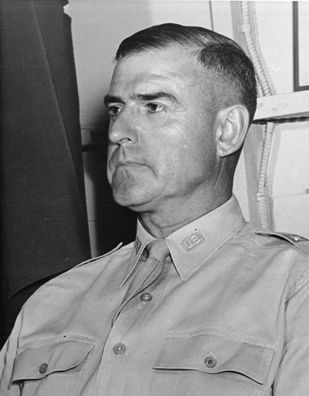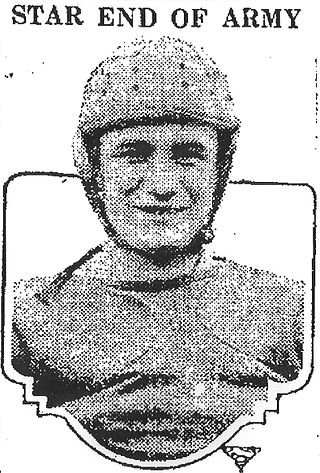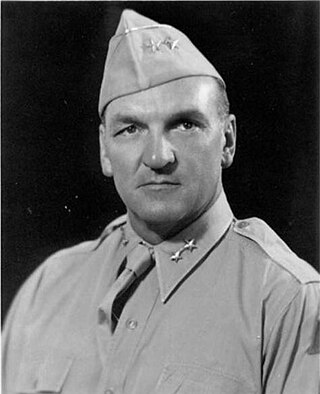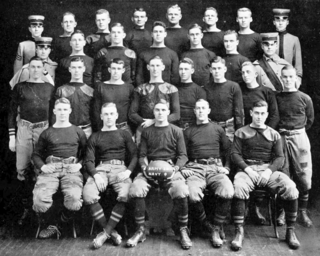
The United States Military Academy (USMA), also referred to metonymically as West Point or simply as Army, is a United States service academy in West Point, New York. It was originally established as a fort during the American Revolutionary War, as it sits on strategic high ground overlooking the Hudson River 50 miles (80 km) north of New York City. It is the oldest of the five American service academies and educates cadets for commissioning into the United States Army.

Omar Nelson Bradley was a senior officer of the United States Army during and after World War II, rising to the rank of General of the Army. He was the first chairman of the Joint Chiefs of Staff and oversaw the U.S. military's policy-making in the Korean War.

The Army–Navy Game is an American college football rivalry game between the Army Black Knights of the United States Military Academy (USMA) at West Point, New York, and the Navy Midshipmen of the United States Naval Academy (USNA) at Annapolis, Maryland. The Black Knights, or Cadets, and Midshipmen each represent their service's oldest officer commissioning sources. As such, the game has come to embody the spirit of the interservice rivalry of the United States Armed Forces. The game marks the end of the college football regular season and the third and final game of the season's Commander-in-Chief's Trophy series, which also includes the Air Force Falcons of the United States Air Force Academy (USAFA) near Colorado Springs, Colorado.

West Point Cemetery is a historic cemetery on the grounds of the United States Military Academy in West Point, New York. It overlooks the Hudson River, and served as a burial ground for Continental Army soldiers during the American Revolutionary War, and for early West Point residents prior to its designation as a military cemetery in 1817.

The Army Black Knights football team, historically known as the Army Cadets, represents the United States Military Academy in college football. The Black Knights team competes in the Football Bowl Subdivision (FBS) of the National Collegiate Athletic Association (NCAA) as a member of the American Athletic Conference. The Black Knights play home games in Michie Stadium with a capacity of 36,000 at West Point, New York. The Black Knights are coached by Jeff Monken, who has held the position since 2014.

"The class the stars fell on" is an expression used to describe the class of 1915 at the United States Military Academy in West Point, New York. In the United States Army, the insignia reserved for generals is one or more stars. Of the 164 graduates that year, 59 (36%) attained the rank of general, more than any other class in the history of the academy, hence the expression.

Lieutenant General Willis Dale Crittenberger was a senior officer of the United States Army. He was a career soldier who served with distinction during the Italian campaign of World War II

Major General Roscoe Barnett Woodruff was a career United States Army officer who fought in both World War I and World War II and served for 38 years. During World War II he commanded divisions and corps in Europe and the Pacific.

Major General Ernest Nason Harmon was a senior officer of the United States Army. He served in both World War I and World War II, and is best known for his actions in reorganizing the 1st Armored Division after the debacle in February 1943 at the Battle of Kasserine Pass during the Tunisian campaign. From January 1945, through the end of World War II, Harmon commanded XXII Corps.

The 1912 Army Cadets football team was an American football team that represented the United States Military Academy as an independent during the 1912 college football season. Under head coach Ernest Graves Sr., the Cadets compiled a 5–3 record and outscored opponents by a total of 108 to 59. The Cadets lost to a one-loss Yale team, a strong Carlisle Indians team led by 1912 decathlon gold medalist Jim Thorpe, and to Navy in the annual Army–Navy Game.

Major General Leland Stanford Hobbs was a decorated senior United States Army officer who commanded the 30th Infantry Division in Western Europe during World War II.

The 1913 College Football All-America team is composed of college football players who were selected as All-Americans for the 1913 college football season. The only two selectors who have been recognized as "official" selectors by the National Collegiate Athletic Association (NCAA) for the 1913 season are Walter Camp and the International News Service (INS). Camp's All-America Team was published in Collier's Weekly. The INS was founded in 1909 by William Randolph Hearst, and its sports editor Frank G. Menke selected the INS All-America team. Other sports writers, newspapers, coaches selecting All-America teams in 1913 included Harper's Weekly, Fielding H. Yost, and Parke H. Davis.

Louis Alfred "Merry" Merrilat (Merillat), Jr. was an American football end and military officer. He played college football with Army and was selected as a first-team All-American in both 1913 and 1914. He was wounded in battle while serving in France during World War I and later played in the National Football League for the Canton Bulldogs in the 1925 NFL season. He became a soldier of fortune, training Iran's Persian Guard, working with the Chinese Army in the 1930s, and serving in the French Foreign Legion.

The Army–Notre Dame football rivalry is an American college football rivalry between the Army Black Knights football team of the United States Military Academy and Notre Dame Fighting Irish football team of the University of Notre Dame. The rivalry dates back to 1913, when both teams were among the top college football programs in the United States.

Major General John Shirley Wood was a United States Army officer who served in World War I and World War II. He is most notable for training and commanding the 4th Armored Division, which spearheaded General George S. Patton's Third Army drive across France in 1944 during World War II.

John French Conklin was an American brigadier general, who served most of his career in the United States Army Corps of Engineers. During the World War II, Conklin served as Chief Engineer, Third U.S. Army.

The 1914 Army Cadets football team was an American football team that represented the United States Military Academy as an independent during the 1914 college football season. In their second season under head coach Charles Dudley Daly, the Cadets compiled a 9–0 record, shut out six of their nine opponents, and outscored all opponents by a combined total of 219 to 20 – an average of 24.3 points scored and 2.2 points allowed. In the annual Army–Navy Game, the Cadets defeated the Midshipmen, 20 to 0. The Cadets also defeated Notre Dame 20–7.

The 1913 Army Cadets football team represented the United States Military Academy in the 1913 college football season. In their first season under head coach Charles Dudley Daly, the Cadets compiled an 8–1 record, shut out five of their nine opponents, and outscored all opponents by a combined total of 253 to 57 – an average of 28.1 points scored and 6.3 points allowed. The Cadets' only loss was against Notre Dame by a 35 to 13 score. In the annual Army–Navy Game at the Polo Grounds in New York City, the Cadets won 22–9.
The 1890 Army Cadets football team represented the United States Military Academy in the 1890 college football season. In the academy's first season fielding a team in intercollegiate football, the Cadets compiled a 0–1 record.

Major General Albert Cowper Smith was an officer in the United States Army. He is most noted for his service as Commanding General of the 14th Armored Division during the later part of World War II. Smith and his division liberated Prisoner-of-war camps, Oflag XIII-B and Stalag VII-A in April 1945.






















